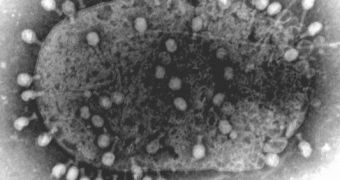Biofilms are slimy layers of bacteria formed by large agglomerations of bacteria, many times of several species, kept together by adhesive molecules. They can appear almost anywhere, even on your teeth when you don't brush them for a day or two. They can be resistant to many types of antibiotics and when they form in hard-to-reach places, like the insides of food processing machines or medical catheters, they can turn into persistent sources of infection.
Now researchers have mutated viruses designed to kill biofilms, a synthetic biology project.
"Our results show we can do simple things with synthetic biology that have potentially useful results," said co-author Timothy Lu, a doctoral student in the Harvard-MIT Division of Health Sciences and Technology.
The new bacteria-attacking virus ("phage") was made employing a "plug and play" gene stock, a method that could be employed to get viruses attacking specific bacteria species.
"The library could contain different phages that target different species or strains of bacteria, each constructed using related design principles to express different enzymes," said lead researcher James Collins, a biomedical engineer at Boston University.
The research could lead to the development of industrial "cleaners," like phages destroying slime in food processing plants or new classes of antibiotics for humans or livestock. The team inserted a gene that encodes an enzyme called dispersin B (DspB) into the genome of T7, a virus that kills the bacterium species Escherichia coli. DspB has been recently found in sewer phages and can degrade a biofilm's molecular scaffolding (extracellular matrix). The new T7 phage was tested on E. coli biofilms and killed 99.997 % of the bugs, much better than non-mutated strains.
Other synthetic biologists want to make a synthetic microbe with the minimum gene set necessary for life. A team led by biologist J. Craig Venter brought to life a cell employing just naked DNA from another species. Their next step is to make a synthetic genome and insert it into a surrogate cell, which could then divide. This would mean the first synthetic life form.

 14 DAY TRIAL //
14 DAY TRIAL //